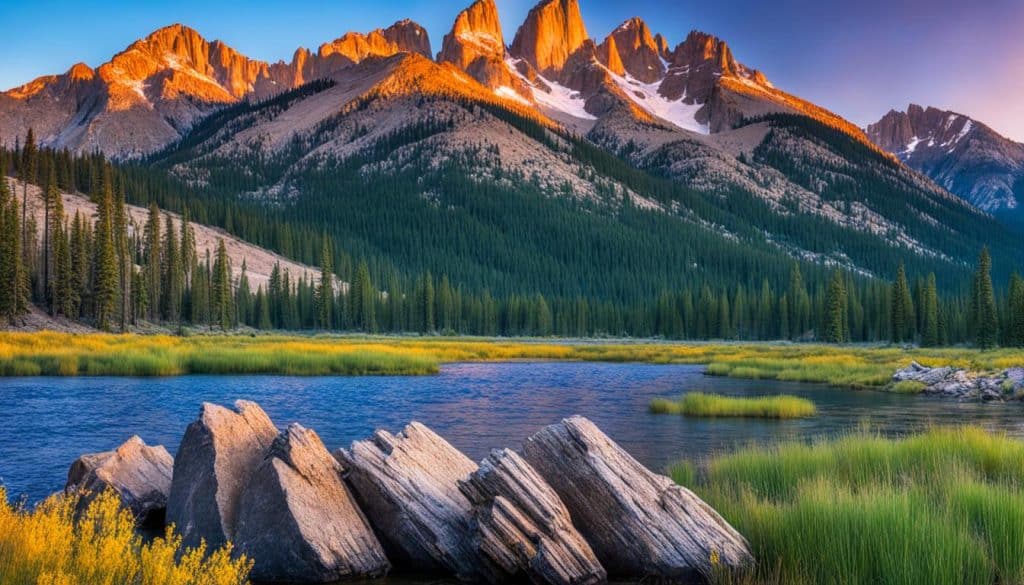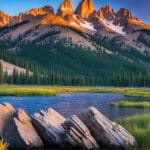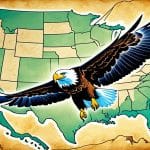The United States is known for its wide range of ecosystems and climates. These features make the country’s ecological diversity rich. From the tall Rockies to the dry Mojave Desert, the USA has many natural habitats. These places are key for plants and animals to live.
This article looks closely at these environments. It shows how they affect the life of the plants and animals living there. Knowing about these ecosystems is important for tackling today’s environmental issues and protecting nature.
Key Takeaways
- The USA boasts a vast range of ecosystems, from mountains to wetlands.
- Diverse climates significantly influence the ecological diversity of the country.
- Understanding natural habitats is crucial for effective conservation strategies.
- Flora and fauna adapt uniquely to their specific environments.
- Addressing ecological challenges is essential for sustaining wildlife and habitats.
- Regional variations enrich the landscape and biological diversity of the USA.
Introduction to the USA’s Ecological Diversity
The United States is home to a wide range of ecological diversity. This is due to its large land area and varied climates. From the warm, lush areas of Florida to the cold, icy tundra of Alaska, each place has its own unique environment.
This variety of environments supports a wide range of plant and animal life. It shows the beauty of USA ecosystems. Each area plays a key role in the overall balance of nature.
It’s important to understand ecological diversity to see how different species and their homes are connected. Protecting these ecosystems is crucial for the future. It helps keep natural resources safe, which are important for both wildlife and humans.
By looking after these habitats, we can keep the natural world healthy for future generations. This is key for the well-being of our planet.
The USA has diverse ecosystems and climates
The United States is home to a wide range of ecosystems. These show how living things and their surroundings work together. We’ll explore the definitions of ecosystems and the unique climate zones in the USA. This helps us see how different habitats keep the environment balanced.
Defining Ecosystems in the USA
Ecosystems are made up of living things like plants, animals, and tiny organisms. They work together with their environment. In the USA, you can find everything from rainforests to deserts, each with its own special features.
These ecosystems are important for many reasons. They help support a wide variety of species and provide homes for them. For example, wetlands clean water, and forests help to store carbon.
Understanding Climate Zones
The USA has different climate zones, like temperate, arid, and tropical areas. These zones affect the types of ecosystems that can live there. For example, deserts are found in arid areas, while temperate zones have forests and grasslands.
This shows how the climate and ecosystems work together. It helps us understand the many different kinds of life in the country.
Mountainous Ecosystems: The Rocky and Sierra Nevada Range
The Rocky Mountains and Sierra Nevada range are key mountainous ecosystems in the United States. They show unique traits, from diverse wildlife to special climates. These are all shaped by their high altitude.
Flora and Fauna of the Rockies
The Rocky Mountains have a wide variety of plants, adapted to the tough high altitude conditions. Key plant species include pine, spruce, and fir trees. These trees are vital for the ecosystem’s balance. Wildflowers like the alpine forget-me-not and mountain heather brighten the landscape in summer.
The Rockies are home to many iconic animals. The mountain goat and black bear are well adapted to the steep slopes. Deer, bighorn sheep, and various birds also live here, making the region rich in biodiversity.
Climate Variations in High Altitude
The high altitude climate of the Rocky Mountains and Sierra Nevada shapes the ecosystem and its inhabitants. Temperatures swing wildly, with warm summers and cold winters. This leads to unique adaptations in plants and animals, helping them survive harsh conditions.
Some areas get a lot of snow in winter, which is crucial for the plants and animals in the dry summer. The mix of climate and life forms shows the complex balance in the Rocky Mountains ecosystems.
Desert Landscapes: The Mojave and Sonoran Deserts
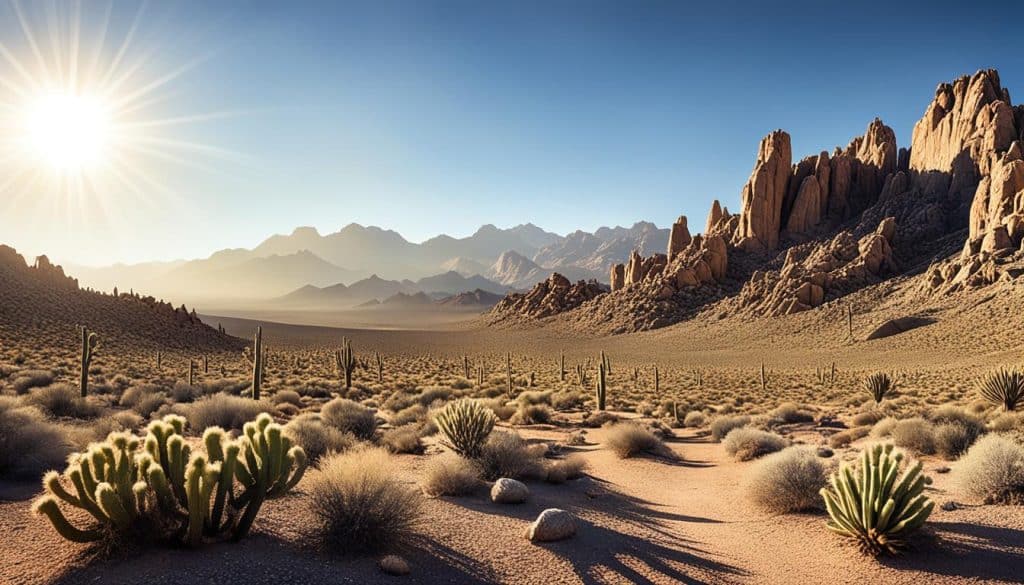
The Mojave and Sonoran Deserts show us how life can thrive in tough conditions. These areas are full of plants and animals that have found clever ways to survive with little water and high heat. Cacti and succulents are perfect examples, using special methods to keep moisture in.
Reptiles like the Gila monster and many snakes do well here. They stay still during the hottest times, hiding in burrows or under rocks. At night, mammals like the kit fox come out to hunt and find food when it’s cooler.
Learning about the Mojave and Sonoran Deserts teaches us about their complex ecosystems. It shows how life can be so resilient. It also tells us why we must protect these unique places.
Coastal Ecosystems: Beaches and Wetlands
Coastal ecosystems in the USA are full of life, from beaches to wetlands. They are key for many animals and plants, helping our planet stay healthy. Learning about them helps us protect these vital places.
The Importance of Coastal Biodiversity
Coastal areas are home to many species, blending beaches with wetlands. They are crucial for birds, marine life, and special plants. Wetlands are important for cleaning water and protecting against floods. This variety of life makes these areas strong against climate change and human effects.
- Support for migratory birds during breeding and nesting seasons.
- Shelter and nursery grounds for marine species, including fish and crustaceans.
- Filtration and purification of water through wetland ecosystems.
- Stability against erosion and damage from storms.
- Enhanced biodiversity increases ecosystem resilience.
Forest Ecosystems: The Appalachian and Pacific Northwest
The Appalachian and Pacific Northwest regions show the rich variety of forest ecosystems in the USA. These areas are known for their unique features. They have many tree species that are vital for the environment. These forests are key to biodiversity, carbon storage, and providing homes for many animals.
Types of Forests Found in the USA
In the USA, forests come in different types, each adding to the local biodiversity. Below is a table that lists the main forest types in the Appalachian and Pacific Northwest regions. It also shows what makes them special:
| Forest Type | Region | Main Species | Characteristics |
|---|---|---|---|
| Deciduous Forests | Appalachian | Oak, Maple, Hickory | Seasonal leaf shedding, vibrant autumn colours |
| Mixed Forests | Appalachian | Pine, Spruce, Fir | Mix of deciduous and coniferous trees |
| Coastal Rainforests | Pacific Northwest | Douglas Fir, Cedar, Redwoods | High rainfall, towering trees, diverse undergrowth |
| Temperate Rainforests | Pacific Northwest | Western Hemlock, Sitka Spruce | Mild temperatures, rich biodiversity, moss-covered trees |
Impact of Climate Change on Forests
Climate change is having a big effect on the Appalachian and Pacific Northwest forests. Changes in temperature and rainfall are moving species around, changing the mix of plants and animals. This makes forests more at risk from pests and diseases, which could harm their health.
It’s crucial to work on conservation to lessen the effects of climate change on these forests. This will help keep these important ecosystems safe and healthy.
Grasslands and Prairies: The Great Plains
The Great Plains in the USA are a key part of the world’s grassland ecosystems. They are known for their vast grasslands and rich wildlife. These areas are home to many species, including wildflowers that grow among the grasses.
These plains are important for grazing animals like bison and antelope. This helps the grassland ecology by creating a complex network of species interactions. For example, the relationship between grazing animals and plants is key to shaping the landscape and keeping the ecosystem healthy.
Fire is crucial for the Great Plains ecosystems. It helps new plants grow and gets rid of invasive species that harm native plants. By clearing dead plant material, fire also helps nutrients cycle back into the soil, supporting the grasslands.
It’s important to understand how these ecosystems work to protect them. By preserving prairie biodiversity and valuing the Great Plains, we can ensure they remain beautiful and thriving for the future.
Biodiversity Hotspots: The Florida Everglades
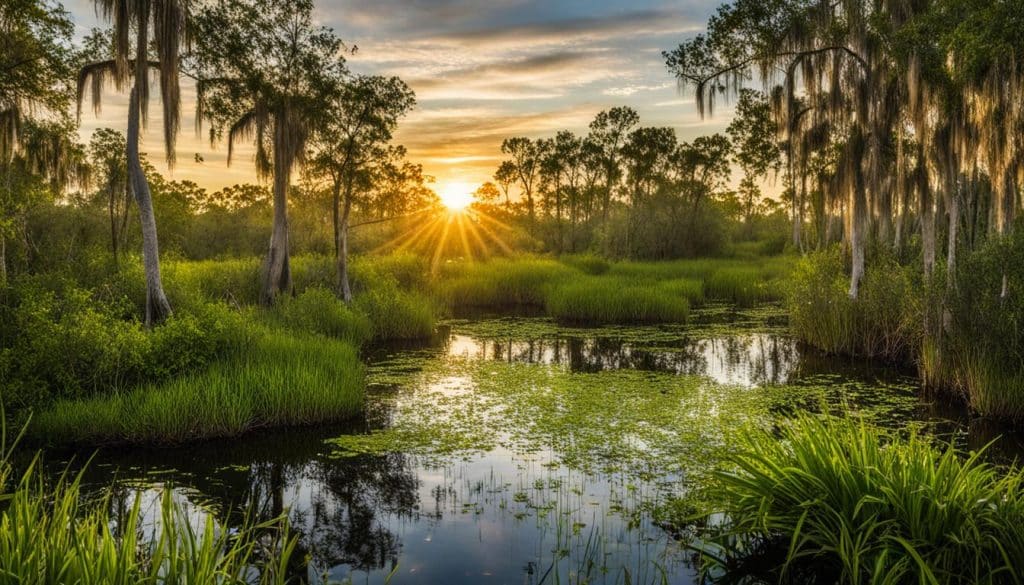
The Florida Everglades is known as a “river of grass.” It’s a key spot for many plant and animal species. This ecosystem is vital for the area’s environmental balance. It has unique habitats like sawgrass marshes and mangrove forests. It’s crucial to protect the Everglades, as it faces threats from pollution and development.
Unique Flora and Fauna of the Everglades
The Everglades is full of life, with many species that depend on it. Some of the highlights include:
- Birds: You’ll find birds like the endangered Roseate Spoonbill and the Great Egret here.
- Reptiles: Alligators and turtles are common, playing important roles in the ecosystem.
- Aquatic Life: Fish like the Florida Gar help keep the ecosystem healthy.
- Plant Life: Plants like sawgrass and cypress trees are key for many species.
Every part of the Everglades works together, supporting life. Protecting these areas is crucial. They show how important natural habitats are for keeping ecosystems stable.
Exploring the Tundra: Alaska’s Arctic Regions
Alaska’s Arctic regions are home to a unique ecosystem known as the Arctic tundra. This area faces extreme cold and short growing seasons. Plants and animals here have adapted in amazing ways to survive.
The main plants are mosses, lichens, and low-growing shrubs. These plants can live in the harsh conditions. They have special ways to get nutrients from poor soil.
Wildlife in Alaska includes caribou and Arctic foxes. Caribou travel long distances to find food, showing their strength and determination. Arctic foxes have thick fur and a small body to keep warm in the cold.
Climate change is a big threat to the tundra. Thawing permafrost upsets the balance of nature and adds to global warming. We need research and conservation to protect these unique places.
| Flora | Fauna | Cold Climate Adaptations |
|---|---|---|
| Mosses | Caribou | Low-growing forms to conserve heat |
| Lichens | Arctic Fox | Thick fur for insulation |
| Low-growing shrubs | Snowy Owl | Compact body structure to retain warmth |
Wetland Ecosystems: Marshes and Swamps
Wetland ecosystems are vital for keeping nature in balance. They include marshes and swamps, which clean water and are homes for many species. These areas are key for storing carbon, controlling floods, and preventing soil erosion.
Significance of Wetlands to Ecosystem Health
Wetlands are crucial for a healthy ecosystem. They are safe havens for many species, boosting biodiversity in marshes and swamps. The mix of plants and animals helps turn nutrients into food for many living things, from tiny bugs to big mammals.
Wetlands also clean polluted water by breaking down harmful substances. They soak up a lot of rain, which helps prevent floods and protects nearby lands.
Adaptations of Wildlife in Wetlands
Wildlife has special traits to live well in wetlands. Amphibians have moist skin for breathing and staying hydrated in wet places. Waterfowl, like ducks, have webbed feet for swimming and finding food in shallow water.
These special traits show how delicate life is in marshes and swamps. They underline why we must protect these wetland ecosystems.
The Role of Conservation in Maintaining Ecosystem Diversity
Ecosystem conservation is key to keeping the USA’s ecological richness. It’s vital for keeping ecosystems healthy. Conservation uses many methods, like setting up protected areas and fixing habitats.
Legislation to protect endangered species is crucial. It supports many conservation efforts. This ensures threatened ecosystems get the protection they need. Local communities and experts work together on these projects, making conservation more effective.
Studies show that local people can make a big difference in saving biodiversity. For example, letting communities manage their resources can increase ecosystem diversity. It also makes people care more about sustainable living.
By following conservation plans, the USA can keep its unique ecosystems safe for the future. Getting communities involved in conservation helps people connect with nature. This creates a lasting way to protect biodiversity.
Climate Challenges: Impact of Global Warming on US Ecosystems
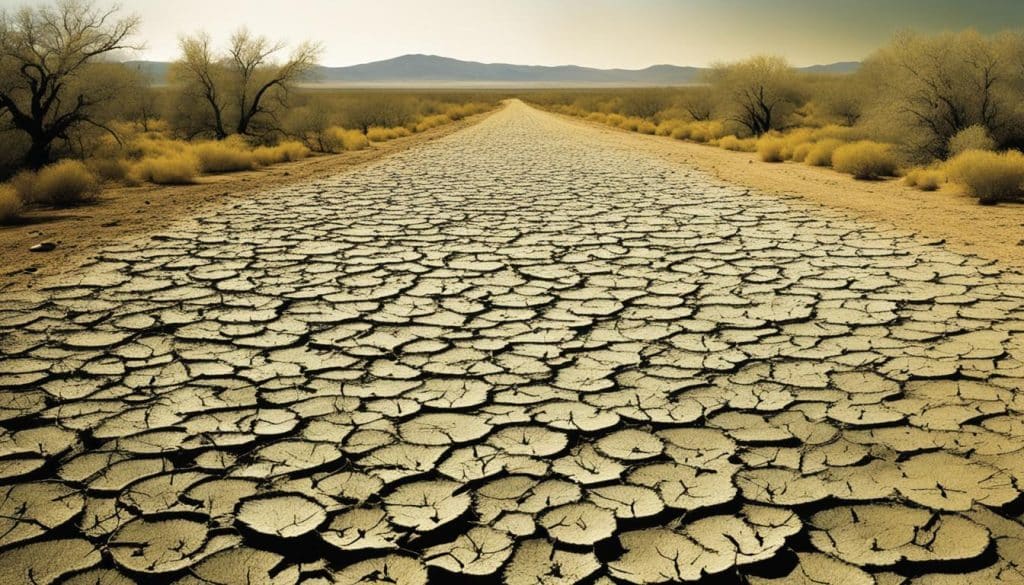
As global temperatures rise, the US’s ecosystems are feeling the effects. It’s vital to understand how climate change affects biodiversity. This helps us see how species are moving to new homes due to climate change.
This change shows how ecosystems are adapting to fast-changing climates. It’s not just about getting used to warmer weather. It’s about how species are coping with big climate shifts.
Shifts in Species Habitats
Species are moving to places that suit them better because of climate change. This means they’re looking for environments that let them survive. We’ve seen some big changes, like:
- Altered migration patterns of birds and other wildlife.
- Flora adapting to new temperature norms, resulting in changes to local ecosystems.
- A potential increase in species competition as habitats overlap.
This shows we need to manage our environment well. We must keep ecosystems in balance.
Extreme Weather and Ecosystem Resilience
Events like hurricanes, droughts, and wildfires worry us about how strong our ecosystems are. Many can adapt and bounce back, but the constant changes make it hard. We should think about:
- The capacity of wetlands to absorb storm surges, protecting surrounding habitats.
- Terrestrial ecosystems that can regenerate after disturbances, fostering new growth.
- The role of keystone species in sustaining ecosystem structures amidst changing conditions.
We need to work on making ecosystems more resilient. This will help fight the bad effects of global warming. We must also adopt sustainable practices that respect these delicate balances.
Tourism and its Effects on Natural Ecosystems
Tourism boosts the economy but also brings environmental challenges. It deeply affects natural ecosystems, with both good and bad sides. More visitors can harm habitats, increase litter, and disturb wildlife. Yet, tourism helps fund conservation efforts, but at a cost to nature’s balance.
Keeping natural areas safe depends on sustainable tourism. By teaching visitors to be responsible, we can lessen harm. Tour operators and governments must educate people about local ecosystems. This encourages visitors to explore with respect.
Now, sustainable tourism is more important than ever. Creating a tourism model that cares for the environment is key. By limiting access to sensitive spots, managing waste, and creating wildlife paths, we can protect nature.
Dealing with tourism’s challenges needs teamwork. Conservation efforts must work with tourism planning. This way, we see ecosystems as precious parts of our world, not just places for fun. They need our respect and care.
Educational Initiatives for Preserving Ecosystem Diversity
Educating people is key to protecting our environment. Many efforts aim to teach the public about the importance of biodiversity. These programs reach out through schools, community groups, and environmental organisations.
Students learn through hands-on activities that deepen their understanding of nature. Schools teach them about the need to protect ecosystems in our daily lives. These lessons make students want to help protect their environment.
Local governments and non-profits work together in community projects. They offer workshops, seminars, and nature walks to teach people about environmental issues. This helps people learn how to help with conservation.
Environmental groups also use digital platforms to spread their messages. They share engaging content on social media to talk about sustainability and conservation. This way, they reach more people and get them interested in protecting nature.
Learning about the environment is very important. It makes people who care about the planet and its problems. As more people learn, we all work together to save our ecosystems for the future.
Technological Innovations in Ecosystem Research
Recent advances in technology in ecology are changing how we study ecosystems. Tools like remote sensing, GIS mapping, and drones help us monitor and understand complex environments. These tools make it easier to collect data and analyze it quickly, helping us study habitats better.
Drone technology gives us a bird’s eye view of ecosystems. This lets researchers see changes in land use, plant life, and animal movements without harming the environment. Remote sensing also helps by collecting important data on temperature, moisture, and plant growth in different areas.
The use of conservation technology in managing ecosystems is also important. Tools like smartphone apps let the public help with research by reporting on local wildlife. This gets more people involved in understanding nature.
Thanks to these technologies, we’re making big strides in conservation. We can quickly make decisions on how to protect habitats and species. This is key to fighting the effects of climate change on nature.
| Technology | Applications | Benefits |
|---|---|---|
| Remote Sensing | Environmental monitoring | Detailed ecosystem analysis |
| GIS Mapping | Mapping biodiversity hotspots | Visualisation of ecosystem changes |
| Drone Technology | Wildlife tracking | Non-invasive data collection |
| Citizen Science Apps | Public participation in research | Increased data collection potential |
These technologies help researchers tackle ecological challenges better. They support a sustainable way to manage ecosystems. The link between technology in ecology and conservation efforts means our most important ecosystems get the care they need to thrive.
The Future of Ecosystems in the USA: Predictions and Hopes
The future of ecosystems in the USA depends on our actions now. We must focus on conservation and climate action. Changes in habitats due to climate will affect biodiversity. We need to work together for ecological sustainability.
Now, many sectors are adopting regenerative practices. This gives us hope for a better future for American ecosystems. By combining conservation efforts with new policies and public awareness, we can improve biodiversity and ecosystem services. Projects like urban green spaces and reforestation show we can make a difference.
The journey ahead is challenging but full of opportunities. Protecting the planet’s natural world is more important than ever. For a sustainable future, we must blend indigenous wisdom with modern technology. This approach will help us create resilient ecosystems that last for generations.

